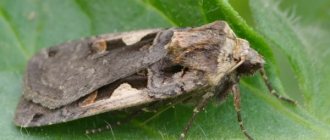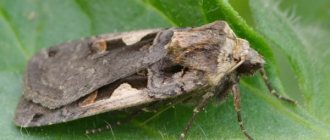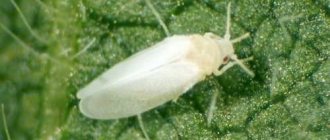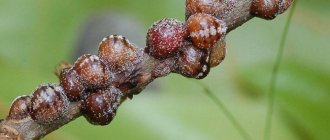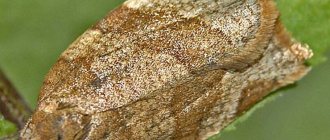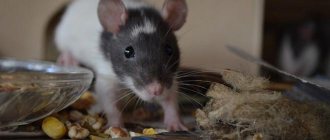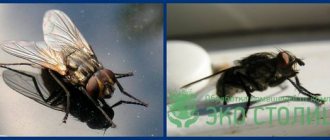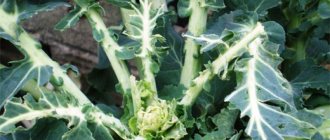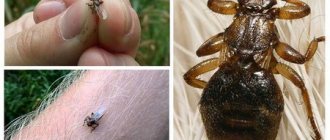Development cycle and harm caused
The carrot fly is equally dangerous to plants both in its larval and adult form. Its life cycle in each season begins in the middle or end of spring, as soon as the soil warms up to a comfortable +15 ° C. The emergence ends with the laying of new eggs at the tops of growing root crops, after which larvae emerge 2 weeks later. They reach no more than 6-7 mm in length and externally resemble brown worms, which move very quickly in the soil and subsequently severely damage the root system of plants.
After 60–75 days, they descend into the soil and begin to pupate, only to fly out again in July or early August. In general, in one season, 2 generations of the pest appear, each of which severely damages root crops, gnawing them almost to the very middle. Most plants dry out after this.
Life cycle
The insect overwinters in the soil, in the form of a pupa . If root crops suddenly remain in the field, the larvae preserved in them can also successfully overwinter.
When the air temperature reaches +15-17°C, flies begin to fly out. This pest loves shade and is found in damp, shaded places, near water and hedges made of living bushes. In open areas, the fly does less harm.
Emerging insects lay eggs in May: from the 15th to the end of the month . If the spring is cold, laying may occur in early June, when the carrots have a couple of leaves. Females lay eggs in the ground near the plants.
Individual insects live for about 12 days. The period of their summer and egg laying is 1-1.5 months .
The larvae appear 4-17 days after the eggs are laid. It depends on the temperature. They feed on plant juices for about 3 weeks, after which they crawl into the soil, where they begin to pupate.
Having pupated, the insects crawl to the surface. From them the second generation of garden pests is formed. Their years begin in mid-July and end in mid-August .
Females lay eggs in densely growing crops. In the fall, some of the larvae manage to pupate, while others end up with the harvest in storage, where they continue to damage it, feeding on the juice of vegetables.
Important: The danger of the insect is that root crops damaged by its larvae cannot be stored for a long time. As a result, most of the crop is destroyed.
Signs and causes of appearance
Traces of the vital activity of any garden pest are noticeable by changes in the appearance of the crops affected by it. If a carrot fly appears in the garden, then first of all it is:
- small holes on the apical part of plants;
- change in color of the tops: first to reddish and then to yellow;
- changing the color of the part of the root crop protruding above the soil to purple;
- damage to the surface of the root crop (if you carefully examine carrots or turnips, you cannot help but notice dark passages);
- cracking of the carrot surface and formation of depressions on it;
- the appearance of an unpleasant odor and deterioration in the taste of the crop: it becomes bitter.
Did you know? The first carrots discovered by ancient man were purple in color and very bitter. Over time, through selection, it was possible to make it more attractive to the taste.
Vegetables damaged by insects will not be stored for long, which is explained not so much by the presence of the pest itself, but by the microbes that have gotten inside (they quickly spread throughout the “body” of the root crop through the passages left by the larvae). The main reasons for this problem usually include:
- waterlogging of beds;
- neglect of the garden and untimely removal of weeds;
- non-compliance with crop rotation rules, especially if pests have already been noticed on the site;
- an abundance of umbrella crops in the beds, the smell of which strongly attracts flies.
The insect loves warm and humid weather, preferring shaded, heavily overgrown areas for breeding. The ideal air temperature is +16...+18 °C, with humidity - 70–80%.
Signs of pest damage
Typically, carrot flies appear in dense plantings where there is humidity and shade. This applies to both carrots and other crops - celery, parsley. You can notice the presence of the pest by a change in the color of the tops of plants, acquiring a bluish or purple-violet hue. Plants gradually stop growing, dry out, and wither.
The dug up root crops show damage - drilled holes, passages, as well as the pest larvae themselves. The carrots become “wooden”, lose their juiciness, taste, and become deformed. Affected root crops rot, look unattractive, and are unsuitable for food or storage.
When harvesting a vegetable, sometimes it is not even visible that the carrots are damaged by the larvae inside. And if such root crops are not removed during sorting, then, when stored in cellars and basements, they begin to rot. The larvae move to healthy carrots in search of food, partially damaging and sometimes completely destroying the crop.
Agrotechnical control measures
Compliance with certain agrotechnical rules for growing garden crops is the easiest method to repel carrot flies from your plot. Starting from choosing the most suitable time for sowing carrots and ending with harvesting work, each stage has its own characteristics.
Sowing time
The smell of seeds and young, immature root crops is very attractive to the carrot fly, so it is better to plan planting work before the pest leaves. In regions with a cold climate, it makes sense to temporarily insulate plants until they get stronger, although in the south of the country it is possible to safely plant crops in open soil as early as April. Vegetable varieties intended for long-term storage are recommended to be sown in late May and until mid-June.
Preparations for carrot flies
If desired, today it is easy to purchase insecticides against any known garden pests. Given the popularity of the carrot fly, it is not surprising that certain means are available to combat it. The list of the most popular drugs includes the following formulations.
"Aktellik"
Belongs to the group of non-systemic organophosphate drugs with enteric contact action. The main active ingredient pirimiphos-methyl allows you to successfully get rid of a number of sucking and leaf-gnawing pests. To successfully combat carrot flies, 1 hectare of plantings will require 300-400 liters of the drug, spraying with which is carried out during the growing season, when insects are first detected and until the fall.
Prevention and how to deal with carrot fly
The carrot fly is very prolific, and the hatched larvae immediately penetrate inside the vegetable. Because of this, it is almost impossible to control the pest with insecticides. Therefore, preventive measures come to the fore in the fight against pests. Moreover, all actions must be carried out in advance.
What to do if carrots are already growing? It is necessary to protect the plantings as much as possible, since the pest can destroy the entire crop. Or rather, not eat, but damage all the crops. There are certain tricks and nuances that will help you avoid or minimize the consequences of the pest.
Sowing
Sowing carrots is carried out in 3 periods: in early spring, in summer at the end of May - beginning of July, and before winter. Experts mostly agree that the best option is summer sowing. So the harvest of this sowing period is guaranteed to last until next spring. It will be stored better than one planted in early spring. And this period maneuvers between the summer of flies.
Planting carrot seeds next to onions, garlic, and tomatoes has worked well—the pest cannot tolerate their smell. Try to sow carrot seeds as rarely as possible so that you don’t have to thin out the plantings later.
To avoid air stagnation and high humidity, make rows for sowing seeds at a distance of at least 30 cm. This way the carrots will not be shaded and moisture in the plantings will be eliminated.
In the spring, after sowing the seeds, cover the bed with covering material; it will protect against pests and also retain moisture longer.
Crop rotation
Carrot fly larvae can live in the soil for up to 3-4 years, or even longer. Therefore, it is best not to plant carrots in the same place for 3-4 years.
Thinning
To avoid the process of thinning the plantings, it is rational to sow granulated seeds, or stick them on tape in advance.
Thinning of plantings is carried out in the evening, on damp soil. And it is better to carry out the first thinning without pulling the seedlings out of the ground, since when thinning the seedlings, flies flock to the smell. It is better to carefully cut off their tops at ground level, under the root. Having pulled the seedling out of the ground, a hole remains in its place, into which the pest lays eggs. Later, the larvae penetrate the root crop, damaging it. The appearance of the root crop and its taste suffer.
Loosening the soil
Loosen the soil between rows throughout the season. The carrots should be completely underground. The exposed part of the root crop is covered with earth so that the fly has no chance of laying eggs. Don't forget to remove weeds on time. Weeds thicken plantings, creating optimal conditions for the breeding of flies.
Folk remedies
Fighting carrot flies with folk remedies is appropriate in cases where you do not want to oversaturate the soil with chemicals. Infusions and decoctions based on various plants and their parts will not harm either the root vegetables themselves or humans, and therefore are deservedly considered absolutely safe. Other household products will be no less effective: for example, ammonia, mustard, wood ash. Each case has its own characteristics of preparation and use of working solutions.
Chemical treatment is an easy way to get rid of pests
Biologically active preparations with a chemical composition are used both at the stage of seed preparation in order to strengthen them and increase the immunity of the first shoots to the carrot fly, and at the stage of the appearance of the pest before and after harvest. Among the most effective and tested in garden conditions are Actellik, Aktaru, Fitoverm, Decis, Arivo, Inta-Vir, etc. Among traditional chemical methods, ordinary kerosene is particularly effective.
When choosing a particular insecticide, you should pay attention to its features and properties. Especially the fact that in addition to being effective in controlling the pest, it must degrade quickly so that the treated vegetables can be eaten immediately after harvest. Chemical treatment is usually carried out in the fall - all the necessary substances are added in mid- or early July, which is effective in combating the second generation of insects.
The standard waiting time for the active components of these drugs to decompose into harmless ones is 2-3 weeks. Before using them, it is recommended to read the instructions for a specific product; sometimes the manufacturer applies additional restrictions.
Stronger pesticides are applied only when there is a large loss of crops and the presence of a large number of pests on the site. The chemicals that are part of such direct-acting insecticides are in any case deposited in the root crop itself, which affects its taste and vitamin properties.
Compliance with all agrotechnical practices, sowing dates, seed treatment before planting, installation of fences and other preventive measures will allow you to preserve the carrot harvest to the maximum. Already damaged, ripe fruits with traces of flies are unsuitable for storage in basements or cellars with “clean” carrots. Even after they are treated with appropriate preparations, fungal and other types of infection will quickly be transmitted to healthy root crops and lead to withering of the entire crop.
